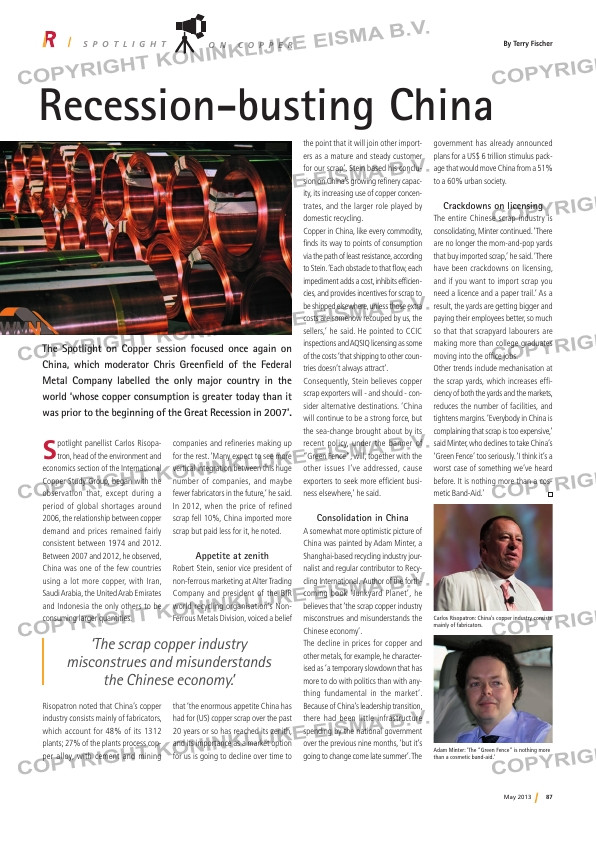Page 87 from: May 2013

87May 2013
Spotlight panellist Carlos Risopa-tron, head of the environment and
economics section of the International
Copper Study Group, began with the
observation that, except during a
period of global shortages around
2006, the relationship between copper
demand and prices remained fairly
consistent between 1974 and 2012.
Between 2007 and 2012, he observed,
China was one of the few countries
using a lot more copper, with Iran,
Saudi Arabia, the United Arab Emirates
and Indonesia the only others to be
consuming larger quantities.
Risopatron noted that China’s copper
industry consists mainly of fabricators,
which account for 48% of its 1312
plants; 27% of the plants process cop-
per alloy, with cement and mining
companies and refineries making up
for the rest. ‘Many expect to see more
vertical integration between this huge
number of companies, and maybe
fewer fabricators in the future,’ he said.
In 2012, when the price of refined
scrap fell 10%, China imported more
scrap but paid less for it, he noted.
Appetite at zenith
Robert Stein, senior vice president of
non-ferrous marketing at Alter Trading
Company and president of the BIR
world recycling organisation’s Non-
Ferrous Metals Division, voiced a belief
that ‘the enormous appetite China has
had for (US) copper scrap over the past
20 years or so has reached its zenith,
and its importance as a market option
for us is going to decline over time to
the point that it will join other import-
ers as a mature and steady customer
for our scrap’. Stein based his conclu-
sion on China’s growing refinery capac-
ity, its increasing use of copper concen-
trates, and the larger role played by
domestic recycling.
Copper in China, like every commodity,
finds its way to points of consumption
via the path of least resistance, according
to Stein. ‘Each obstacle to that flow, each
impediment adds a cost, inhibits efficien-
cies, and provides incentives for scrap to
be shipped elsewhere, unless those extra
costs are somehow recouped by us, the
sellers,’ he said. He pointed to CCIC
inspections and AQSIQ licensing as some
of the costs ‘that shipping to other coun-
tries doesn’t always attract’.
Consequently, Stein believes copper
scrap exporters will – and should – con-
sider alternative destinations. ‘China
will continue to be a strong force, but
the sea-change brought about by its
recent policy, under the banner of
“Green Fence”, will, together with the
other issues I’ve addressed, cause
exporters to seek more efficient busi-
ness elsewhere,’ he said.
Consolidation in China
A somewhat more optimistic picture of
China was painted by Adam Minter, a
Shanghai-based recycling industry jour-
nalist and regular contributor to Recy-
cling International. Author of the forth-
coming book ‘Junkyard Planet’, he
believes that ‘the scrap copper industry
misconstrues and misunderstands the
Chinese economy’.
The decline in prices for copper and
other metals, for example, he character-
ised as ‘a temporary slowdown that has
more to do with politics than with any-
thing fundamental in the market’.
Because of China’s leadership transition,
there had been little infrastructure
spending by the national government
over the previous nine months, ‘but it’s
going to change come late summer’. The
government has already announced
plans for a US$ 6 trillion stimulus pack-
age that would move China from a 51%
to a 60% urban society.
Crackdowns on licensing
The entire Chinese scrap industry is
consolidating, Minter continued. ‘There
are no longer the mom-and-pop yards
that buy imported scrap,’ he said. ‘There
have been crackdowns on licensing,
and if you want to import scrap you
need a licence and a paper trail.’ As a
result, the yards are getting bigger and
paying their employees better, so much
so that that scrapyard labourers are
making more than college graduates
moving into the office jobs.
Other trends include mechanisation at
the scrap yards, which increases effi-
ciency of both the yards and the markets,
reduces the number of facilities, and
tightens margins. ‘Everybody in China is
complaining that scrap is too expensive,’
said Minter, who declines to take China’s
‘Green Fence’ too seriously. ‘I think it’s a
worst case of something we’ve heard
before. It is nothing more than a cos-
metic Band-Aid.’
S p o t l i g h t o n C o p p e r By Terry Fischer
‘The scrap copper industry
misconstrues and misunderstands
the Chinese economy.’
Recession-busting China
The Spotlight on Copper session focused once again on
China, which moderator Chris Greenfield of the Federal
Metal Company labelled the only major country in the
world ‘whose copper consumption is greater today than it
was prior to the beginning of the Great Recession in 2007’.
Adam Minter: ‘The “Green Fence” is nothing more
than a cosmetic band-aid.’
Carlos Risopatron: China’s copper industry consists
mainly of fabricators.
RI-4_Spotlight Copper.indd 87 03-05-13 14:42



